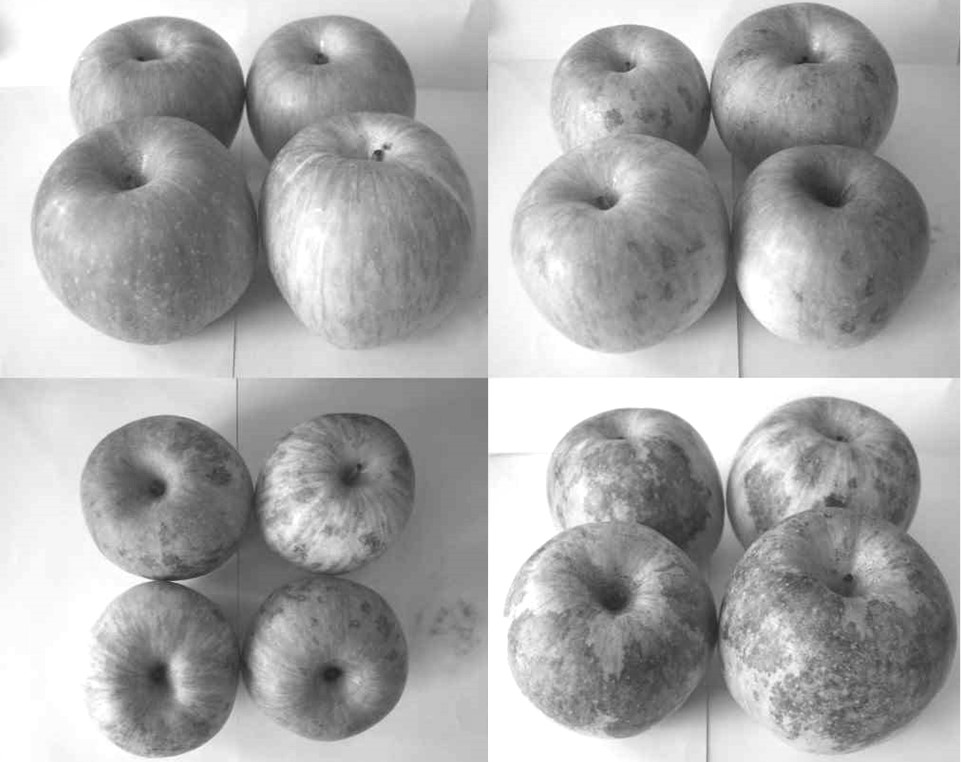Rapid prediction technology for epidermis diseases at last storage stage of apples
A prediction technology and disease technology, which is applied in the field of rapid prediction of epidermal diseases at the end of apple storage, can solve problems such as complicated operations, and achieve the effect of simplifying the dyeing process and improving the dyeing efficiency.
- Summary
- Abstract
- Description
- Claims
- Application Information
AI Technical Summary
Problems solved by technology
Method used
Image
Examples
Embodiment 1
[0023] Example 1 Establishment of a prediction model for epidermal diseases at the end of storage of apples
[0024] The xylene cyanol and the fast penetrant T were dissolved to prepare a homogeneous solution of 1.5 g / L and 3% respectively, and 270 fruits of uniform size, no diseases and insect pests, and no obvious mechanical damage were picked from each of 12 orchards for 5 consecutive years. The fruits of each picking orchard were divided into 3 groups (three repetitions), respectively immersed in the dyeing solution for 90 minutes, then taken out, rinsed with clean and flowing tap water, and observed the dyeing index after 2 hours. Fruits with different dyeing levels were treated with apples Ordinary polyethylene fresh-keeping bags commonly used in the cold storage of the origin are packaged, and then put into a carton and stored in a cold storage with a relative humidity (RH) of 85% to 90% for 7 months, and the disease is counted after being taken out and placed for 24 hou...
Embodiment 2
[0027] Dissolving xylene cyanol and fast penetrating agent T to prepare 1.5 g / L and 3% homogeneous solutions respectively, and picking fruits with uniform size, no diseases and insect pests, and no obvious mechanical damage in a typical orchard in Zhaoyuan, the main apple producing area of Shandong Province 270 apples, divided into 3 groups (three repetitions), immersed in the dyeing solution for 90 minutes, then taken out, rinsed with clean and flowing tap water, observed the dyeing index after 2 hours, and then used ordinary polyethylene fresh-keeping bags commonly used in refrigerators in the origin of apples. Packed, and then put in a carton for 7 months in a refrigerator with a relative humidity (RH) of 85% to 90% at (0±1)℃, and the disease index was counted after being taken out and placed for 7 days.
[0028] The dyeing rate was 33.6%, the predicted disease occurrence index was 8.01%, the actual disease occurrence was 9.0%, the error was 0.99%, and the accuracy was hig...
Embodiment 3
[0030] Dissolving xylene cyanol and fast penetrating agent T to prepare 1.5 g / L and 3% homogeneous solutions respectively, and picking fruits with uniform size, no diseases and insect pests, and no obvious mechanical damage in a typical orchard in Wendeng, the main apple producing area of Shandong Province 270 Divide them into 3 groups (three repetitions), immerse them in the dyeing solution for 90 minutes, then take them out, rinse them with clean and flowing tap water, observe the dyeing index after 2 hours, and then pack them in ordinary polyethylene fresh-keeping bags commonly used in refrigerators in the origin of apples. , and then put it into a carton for 7 months in a refrigerator with a relative humidity (RH) of 85% to 90% at (0 ± 1) ℃, and then take out and place for 7 days to count the disease index.
[0031] The dyeing index was 54.6%, the predicted disease occurrence index was 13.43%, the actual disease occurrence was 11.6%, the error was 1.83%, and the accuracy ...
PUM
 Login to View More
Login to View More Abstract
Description
Claims
Application Information
 Login to View More
Login to View More - R&D
- Intellectual Property
- Life Sciences
- Materials
- Tech Scout
- Unparalleled Data Quality
- Higher Quality Content
- 60% Fewer Hallucinations
Browse by: Latest US Patents, China's latest patents, Technical Efficacy Thesaurus, Application Domain, Technology Topic, Popular Technical Reports.
© 2025 PatSnap. All rights reserved.Legal|Privacy policy|Modern Slavery Act Transparency Statement|Sitemap|About US| Contact US: help@patsnap.com



